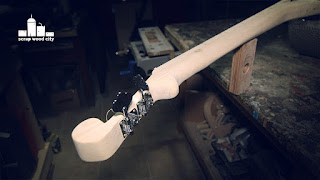Recently I found a broken washing machine drum. I got the idea to make a contrabass using the drum and a spruce 2x4.
First of all I used my drill with a wire brush bit to clean all the salts and dirt.
I then used my angle grinder to grind of the heads of the rivets that hold the flanges in place. I then used an old chisel to remove the flanges.
With the angle grinder I opened up the holes on the sides.
I removed the little doors and bended the sharp sheet metal edges with a pair of pliers to make the piece safer.
Using my jigsaw I cut the basic shapes out of a 2x4.
I then created two grooves with my a handsaw and a chisel. Those would receive the edges of the drum.
The contrabass is standing on a tapered foot. I marked a circle at the end of the 2x4 and used my draw knife to remove much material. I finished the job with a spokeshave.
I then marked the center of the fingerboard. Again I used the spokeshave to shape the back of the neck. The spots that couldn’t be reached with the spokeshave, I shaped using rasps and files. I use the rasp to remove much stock fast. The I use a less aggressive file to remove the rasp’s marks.
I planed the surface that would receive the fingerboard flat with a plane.
Using the table saw I ripped cut the fingerboard.
To avoid the fingerboard from sliding around while glue up. I used two small nails to keep it in place. I then glued the fingerboard in place using glue and clamps.
I then planed the sides of the fingerboard flat using a hand plane.
I sanded everything with 100grit sandpaper and finished shaping.
To sand the fingerboard flat, I used a flat foot from an old IKEA table as a sanding block. Using double sided tape I glued a piece of sandpaper on it.
I broke the sharp edges using my block plane.
I drilled the holes for the tuning pegs. I also predrilled pilot holes and secured the pegs in place with screws.
I clamped the wood temporarily on the washing machine drum, to mark the locations of the holes I had to make. I actually took advantage of the existing holes of the drum. I only enlarged them with my drill.
I secured the wood on the drum with four ball headed screws. I also predrilled holes to avoid spitting of the wood.
Using a handsaw and a small file I opened up a groove that would receive the nut bone.
Using a sanding disc on my angle grinder, I flattened the area that would receive the bridge.
I then made the bridge from a scrap piece of walnut wood. I cut it to size on the bandsaw and shaped it with my disc sander.
I predrilled pilot holes and screwed the string guides in place.
Using a small file I opened up the slots on the nut for the strings.
I then measured my string’s length from nut to bridge. My scale was 87cm. I used an online fret calculator to divide the fingerboard. I first used a pencil to mark the fret positions temporarily. I used my pyrographer to burn the marks permanently.
At this point my bass was ready. It has a cool metallic sound. I am really happy with the way it came out, I hope you like it too.















A slab cut piece of softwood will bend under the string pressure. Quarter cut hardwood would be way better.
ReplyDeleteThis comment has been removed by a blog administrator.
ReplyDeleteThis comment has been removed by a blog administrator.
ReplyDeleteWhat make and year was the washing machine? Was is a really old one or what?
ReplyDeleteDo you remember make model and year, I know that's a weird question? Just interested but can't find one like u have there sir??
ReplyDeleteHow loud is this bass please? It seems like a great project!
ReplyDelete